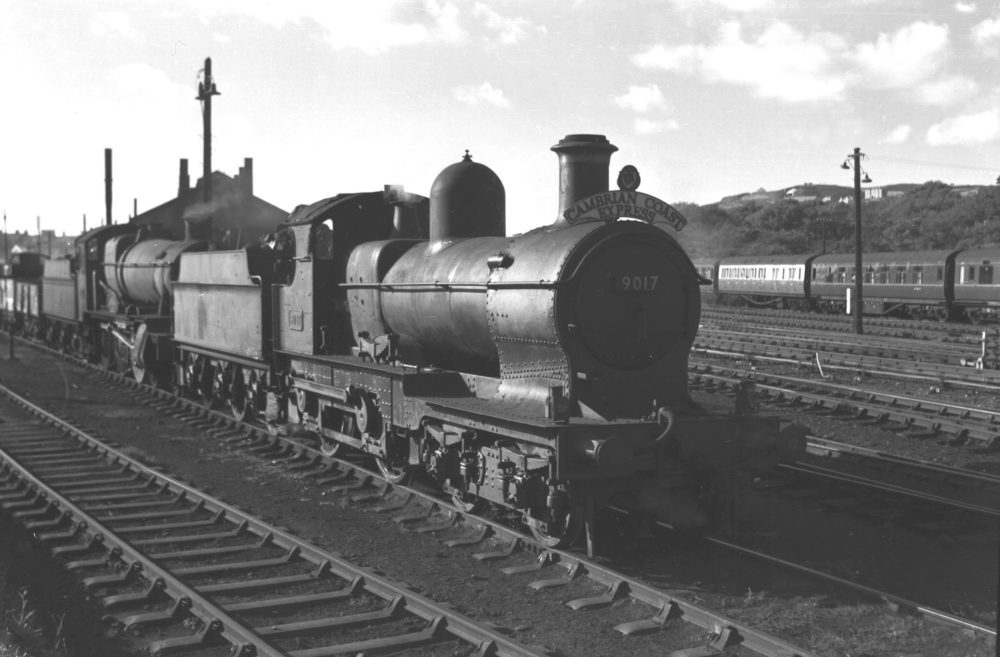‘Dukedog’ locomotive returns to Wales for first time in 60 years

A popular ‘Dukedog’ locomotive is returning to a Welsh town for the first time in over 60 years.
‘Dukedog’ No.9017 will be arriving in the town in late February, for static display in the new Museum & Display Space at the Vale of Rheidol Railway. The 85 year old locomotive is on loan from the Bluebell Railway in Sussex.
The locomotive is nicknamed a ‘Dukedog’ because it is a hybrid of two different classes of engine: the underframe of a ‘Duke’ locomotive combined with the boiler of a ‘Bulldog’.
Long association
‘Dukedog’ locomotives have a long association with Aberystwyth, having been a regular sight working trains between Aberystwyth, Machynlleth and Pwllheli in steam days.
The last ‘Dukedog’ locomotive left Aberystwyth in May 1960 and one has not returned to the town until now.
Llŷr ap Iolo, Vale of Rheidol Railway managing director, said: “We are very excited to announce the loan of this locomotive to go on public display here in Aberystwyth. I am very grateful to the board of the Bluebell Railway for making this loan possible.
“As part of the project to construct our new museum, standard gauge track was laid to facilitate this kind of visit: the ‘Dukedog’ seemed the perfect choice to be the first standard gauge locomotive to be put on display.”
“Fascinating machine”
The locomotive is normally based at the Bluebell Railway, where it has lived for the last 60 years. The locomotive went out of traffic for repairs in 2011 and has been hidden away in undercover storage since then.
Neil Glaskin, Bluebell Railway operations and commercial director, said: “We are really pleased to be able to work with The Vale of Rheidol Railway to bring the Dukedog back to Aberystwyth.
“Since 2011, the locomotive has been stored undercover but this has meant limited chances for the public to see it. By displaying the loco in the new museum everyone will have the chance to admire this fascinating machine.”
Return to Wales
The locomotive was built in Swindon Works in 1938 for the Great Western Railway and spent its working life in Wales, where it worked over the Cambrian lines to Pwllheli and Aberystwyth.
It was light enough to work over Barmouth Bridge, so remained in regular use until the 1950s despite its antiquated appearance.
John ‘Abergynolwyn’ Davies, 94, who still lives in Aberystwyth, worked on the ‘Dukedog’ locomotives when they were based in Ceredigion in the 1950s.
He said: “I spent a glorious week in the summer of 1955 firing No.9017 with driver Tom Phillips. We worked the 9.55am ‘all stations’ from Aberystwyth to Welshpool each day, where we serviced the engine: our return working was the Cambrian Coast Express, all the way to Aberystwyth. Working with Tom felt like a ‘holiday job’ because of his light handling of the loco.”
John recalled: “We were climbing Talerddig bank with No.9017, when Tom said: ‘shall I show you how to get the best out of a Dukedog?’. I stood in the driving position, as he gave me a demonstration of the easiest way to fire it. The loco performed well all week: it was one of the best working weeks of my life.”
Display
The ‘Dukedog’ will be on display in the restored 1938 engine shed at Aberystwyth station from March 2024 onwards.
This building has recently been transformed into a museum, display and events space as part of a larger project called “Wales to the World”, which is developing the terminus at Park Avenue into a Great Western-style station suitable for the modern tourist.
This location is especially significant for No.9017, as it will be displayed in the building where it was based and used to work in the 1950s.
The public will be able to view the ‘Dukedog’ at the Vale of Rheidol Railway from March 23 onwards, when the railway opens for the season. The railway and museum are then open daily until the start of November.
Support our Nation today
For the price of a cup of coffee a month you can help us create an independent, not-for-profit, national news service for the people of Wales, by the people of Wales.







“the underframe of a ‘Duke’ locomotive combined with the boiler of a ‘Bulldog’.” In fact it is the other way around; a Duke boiler on Bulldog frames. But Aberystwyth is a very good place to display the engine. They were long associated with the Cambrian section of the GWR, which before the Grouping had been Wales’ own railway system, “Cambrian Railways” (note the plural). The Dukedogs’ predecessors, the Dukes, had done good work on the Cambrian, but by the 1930s were beginning to wear out. A few lasted into the late 1940s but not many. Thirty years is a good… Read more »
The black engine trains that came through Abermaw some years ago were so popular with enthusiasts, a photo on the bridge was a must. It stood in the station like some living, breathing, snorting and slavering massive mythical beast. Perhaps you could remind me of its class name…
No idea, I’m afraid. Steam tours use all sorts of engines, some a good deal bigger than were used in regular traffic back in steam days. I have seen photos of a Stanier Black 5 on the Cambrian, which would certainly not have run there back in BR days; also BR Standard class 4 light 4-6-0s and 2-6-0s, both of which were possibilities. The BR Standard class 4 2-6-4Ts were used, as was the little class 3 2-6-0. Hope that is helpful.